Agricultural Sciences
Vol.3 No.8(2012), Article ID:25594,11 pages DOI:10.4236/as.2012.38124
Improving crop yield, N uptake and economic returns by intercropping barley or canola with pea
![]()
Agriculture and Agri-Food Canada, Melfort, Canada; sukhdev.malhi@agr.gc.ca
Received 5 September 2012; revised 22 October 2012; accepted 19 November 2012
Keywords: Barley; Canola; Crop yield; Economic returns; Intercrop; N Fertilizer; N Uptake; Oil; Pea; Protein
ABSTRACT
Two field experiments were conducted from 2009 to 2011 on a Gray Luvisol (Typic Haplocryalf) loam at Star City, Saskatchewan, Canada, to determine the effectiveness of intercropping barley or canola with pea in improving crop yield, total N uptake, seed quality, Land Equivalency Ratio (LER) and economic returns compared to barley, canola or pea grown as monocultures. Average seed yields of barley-pea or canola-pea intercrops were usually greater than those of barley, canola or pea as sole crops. In intercrops, application of N fertilizer increased seed yield of barley or canola but had only slight beneficial effect on the combined seed yield of both crops together. The LER values for intercrops were usually much greater than 1, suggesting less land requirements of intercropping systems than monoculture for the same seed yield. Net returns were lowest for barley as sole crop. Without applied N, net returns were slightly lower for barley-pea intercrop and slightly greater for canola-pea intercrop than pea as a sole crop. Generally, protein concentration in canola or barley seed was higher and oil concentration in canola seed was lower in intercrop combinations compared to sole crops. Response trends of total N uptake in seed or straw were usually similar to that of seed or straw yield. In conclusion, intercropping barley or canola with pea improved yield, N uptake and net returns, suggesting the potential of barley-pea or canola-pea intercrops and pea for organic farming systems.
1. INTRODUCTION
Intercropping refers to growing two or more distinct crops in the same field at the same time. Intercropping, especially a mix of non-legume and legume crops, can have many benefits. Intercropping adds diversity to the cropping system, resulting in the stability of production by lowering risk of crop failure in barley-pea intercropping [1,2]. Intercropping may reduce input costs by lowering fertilizer and pesticide requirements, and thus increase economic returns for mustard-pea or barley-pea intercrops [3,4], and also improve harvest ability of crops in cereals-pea or cereal-lentil intercrops [5,6]. Intercropping can also lead to extra yield [also called out-yielding (i.e., when the yield produced by an intercrop is greater than the yield produced by the component crops grown in monoculture on the same total land area)] in cereallegume [2,3,7-10] or oilseed-legume [3,10] intercropping systems, and grain quality [5,11]. Out-yielding can be calculated by measuring productivity efficiency of intercrops relative to sole crops by using various methods, such as Area x Time Equivalency Ratio (ATER) [12], Relative Yield Total (RYT) [13] or Land Equivalency Ratio (LER) [14]. However, the LER is most commonly used to make intercrop versus sole crop comparisons, and is defined as the relative land area under sole crops that is required to produce yields equivalent to intercrops.
There are many reasons for the occurrence of outyielding in intercropping systems. Weed suppression [6,15] and lower susceptibility to insects and diseases may increase yields of intercrops [16-18]. This is also possible that a mixture of different crop plants will use resources (e.g., nutrients, water and light) more efficiently than crop plants of the same type, and may also provide mutual benefits to each other, such as fixed nitrogen (N) from legumes, root length [2,19-21]. The magnitude of beneficial effects of intercropping nonlegumes with legumes on yield, produce quality, nutrient uptake and economic returns vary with crop species, soil type and climatic conditions (agro-ecological regions). In Canada, especially in the Parkland region, research information is lacking on the effects of intercropping nonlegume and legume annual crops on crop yield, seed quality and economic returns. The purpose of this study was to determine the feasibility of intercropping annual non-legume (oilseeds or cereals) and legume (pea) crops for optimum yield, produce quality and economic returns.
2. MATERIALS AND METHODS
2.1. Field Experimentation
Two field experiments (Experiment 1 with barley-pea intercrop; Experiment 2 with canola-pea intercrop) were established in 2009 on a Gray Luvisol (Typic Haplocryalf) loam at Star City, Saskatchewan, Canada. Some characteristics of the soil used in these experiments are presented in Table 1. Soil was low in available N. Precipitation in the growing season (May, June, July and August) from 2009 to 2011, and long-term (30-year) average of precipitation and air temperature in May to August at the nearest Environment Canada Meteorological Station (AAFC Melfort Research Farm) are presented in Table 2. The amount of precipitation in the growing season over four months from May to August was 226.0 mm, 403.0 mm and 198.0 mm, in 2009, 2010, and 2011, respectively. The precipitation for the 30-year average at the nearest meteorological station (Melfort) was 243.7 mm. In 2009, the growing season precipitation (GSP) was near longterm average, with slightly lower than average precipitation in May and slightly higher than average precipitation in August. In 2010, the GSP was much higher than average (especially in June, and also in April prior to spring), and relatively cooler air temperatures in most summer. In 2011, the GSP was below average (especially in May during seeding season and in August during seed formation/filling), with relatively cooler air temperatures and wet conditions in June, and relatively warmer/hotter air temperatures and dry moisture conditions in late July and August.
In both experiments, there were 10 treatments, where barley and pea (Experiment 1), or canola and pea (Experiment 2) were grown as monocrops and in combinations, and N fertilizer at 0, 40 and 80 kg·N·ha–1 was applied to monocrops barley and canola and their combination with pea. In Experiment 1, the treatments were: 1) barley, 0 kg·N·ha–1, 2) barley, 40 kg·N·ha–1, 3) barley, 80 kg·N·ha–1, 4) pea, 0 kg·N·ha–1, 5) barley-pea in alternate rows, 0 kg·N·ha–1, 6) barley-pea in alternate rows, 20 kg·N·ha–1 to only barley, 7) barley-pea in alternate rows, 40 kg·N·ha–1 to only barley, 8) barley-pea in same row, 0 kg·N·ha–1, 9) barley-pea in same row, 20 kg·N·ha–1, and 10. barley-pea in same row, 40 kg·N·ha–1. In Experiment 2, the treatments were: 1) canola, 0 kg·N·ha–1, 2) canola, 40 kg·N·ha–1, 3) canola, 80 kg·N·ha–1, 4) pea, 0 kg·N·ha–1, 5) canola-pea in alternate rows, 0 kg·N·ha–1, 6) canola-pea in alternate rows, 20 kg·N·ha–1 to only canola, 7) canola-pea in alternate rows, 40 kg·N·ha–1 to only canola, 8) canola-pea in same row, 0 kg·N·ha–1, 9) canola-pea in same row, 20 kg·N·ha–1, and 10) canola-pea in same row, 40 kg·N·ha–1. In the two experiments, canola and barley were rotated in alternate years. Each treatment was

Table 1. Some characteristics of soil in spring 2009 at initiation of field experiments at Star City in northeastern Saskatchewan.

Table 2. Growing season monthly and total precipitation in 2009 to 2011 growing seasons, and average 30-yr average precipitation and temperature at Star City in northeastern Saskatchewan.
replicated four times in a randomized complete block design. Each experimental unit (plot) was 1.8 m × 7.5 m. All plots received blanket applications of P, K and S fertilizers. The crops were seeded in rows 17.8 cm apart, with 10 rows per plot. In the barley-pea intercrop Experiment 1, no herbicide was applied and weeds were controlled manually by hoeing whenever needed. In the canola-pea intercrop Experiment 2, herbicide Solo (a.i., imazamox) was applied to control annual weeds in both canola and pea. We did not observe any visual symptoms of disease in any crop, so no fungicide was applied. At maturity, the crop was harvested with a combine for seed yield. Plant samples were also harvested for biomass and straw yield. Seed and straw samples were analysed for total N concentration [22] to calculate N uptake.
2.2. Land Equivalency Ratio
To compare crop growth/yield in intercrops relative to the respective sole crops, LER was calculated by using formula [LER = (Intercrop1/Sole Crop1) + Intercrop2/ Sole Crop2)] of Szumigalski and Van Acker [14]. The LER value greater than 1 indicated out-yielding with intercropping (i.e., greater production and lower land requirement with intercropping compared to sole crops). On the other hand, the LER value less than 1 suggested under-yielding with intercropping (i.e., lower productivity and greater land requirement with intercropping than the sole crops).
2.3. Statistical Analysis
The various treatments were applied to the same plots every year over three years to include any residual cumulative effects of the treatments over time. In additionthe response trends of crops to various treatments were generally similar in all three years. Because of these reasons, the data for each parameter in each experimental unit were averaged over three years [23], and then these calculated means were subjected to analysis of variance (ANOVA) using procedures as outlined in SAS [24]. Significant (p ≤ 0.05) differences between treatments were determined using least significant difference (LSD0.05). The LSD and standard error of the mean (SEM), along with significance for different parameters are presented in the various tables.
3. RESULTS
3.1. Barley-Pea Intercrop (Experiment 1)
3.1.1. Yield, Land Equivalency Ratio and N Uptake
Seed yield of barley as sole crop increased substantially with application of N, and also increased significantly in both intercrop combinations (Table 3). Seed yield of pea decreased with increasing N fertilizer application in both intercrop combinations, and more so seeding in the same row intercrop. The LER values for the corresponding N rate treatments in barley-pea intercrop combinations were greater than 1 in all cases. The LER values were highest when no N was applied to intercrops, but decreased with application of N fertilizer at 20 or 40 kg·N·ha–1. Total N uptake in seed for barley and pea as sole crops as well as when sown as intercrop in both combinations showed trends similar to seed yield (Table 3). The LER values for total N uptake in seed also showed patterns similar to LER for seed yield, but the actual LER values were usually greater for total N uptake in seed than for seed yield.

Table 3. Seed yield, N uptake of seed and land equivalency ratio (LER) for barley and pea, grown as sole crops or in various intercrop combinations at Star City, Saskatchewan (average of 2009 to 2011, Experiment 1).
The LER values in both barley-pea intercrop combinations were greater when sole crop of barley was grown at zero-N rate compared with application of N fertilizer, with the least at 80 kg·N·ha–1 rate (Table 4). This indicated crop yield would be highest and land requirement would be lowest for barley-pea intercropping, when sole crop is grown without any applied N fertilizer. The LER values were only slightly greater than 1 in many cases when barley received 80 kg·N·ha–1, suggesting decrease in seed yield and increase in land requirement for barley sole crop receiving increasing rate of applied N. For barley as sole crop particularly at 0 and also at 40 kg·N·ha–1 rates, the LER values increased with increasing N rate from 0 to 40 kg·N·ha–1 in both barley-pea intercrop combinations, with the highest LER values when the barley-pea intercrop combinations received N fertilizer at 40 kg·N·ha–1. This suggested that seed yield increased and land requirement decreased for barley-pea intercrop with increasing rate of applied N. The LER values for total N uptake in seed also showed response trends similar to LER for seed yield (Table 4).
Total of seed and straw yield of barley + pea together in both intercrop combinations increased with applied N, but the increases were much smaller for seed yield than straw yield (Table 5). Seed and straw yield of barley as sole crop increased considerably with application of N. Seed and straw yield of pea as sole crop was greater than barley as sole crop receiving no N fertilizer for seed yield and 0 and 40 kg·N·ha–1 rates for straw yield, but were lower than both intercrop combinations in all cases.
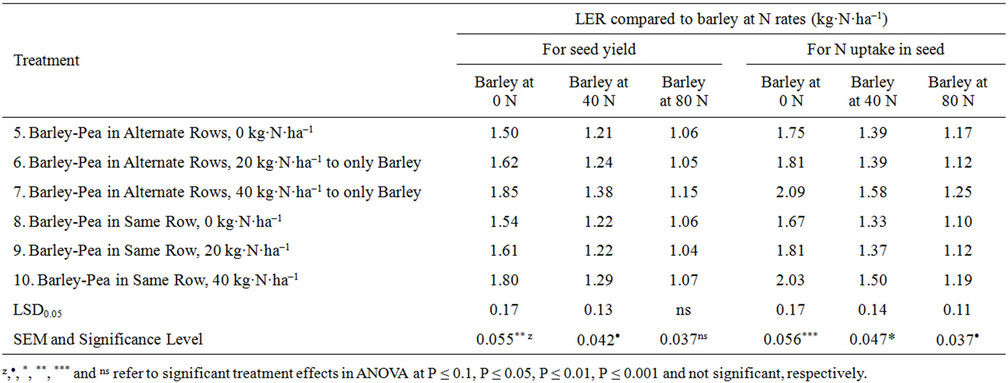
Table 4. Land equivalency ratio (LER) for barley with or without applied N and pea without applied N grown as sole crops or in various intercrop combinations at Star City, Saskatchewan (average of 2009 to 2011, Experiment 1).

Table 5. Yield and N uptake of seed, straw and seed + straw for both crops of barley and/or pea together, grown as sole crops or in various intercrop combinations at Star City, Saskatchewan (average of 2009 to 2011, Experiment 1).
Seed + straw yields usually followed trends similar to straw yields. Response trends of total N uptake in straw or seed + straw to various treatments were also similar to corresponding straw yield or seed + straw yield (Table 5).
3.1.2. Seed Quality
Protein concentration in barley seed was highest when barley was intercropped with pea in alternate rows without any applied N (Table 6). Protein concentration in barley seed tended to decrease with N fertilization in barley-pea intercrop combination in alternate rows, but no effect on protein concentration in seed when both crops were seeded in the same row. There was no consistent effect of any treatment on protein concentration in pea seed.
3.1.3. Economic Returns
Net returns of barley as a sole crop increased substantially with application of N, but still were much lower than both barley-pea intercrop combinations in all three crop price scenarios (Table 7). Net returns for barley-pea intercrop without applied N were slightly lower than pea
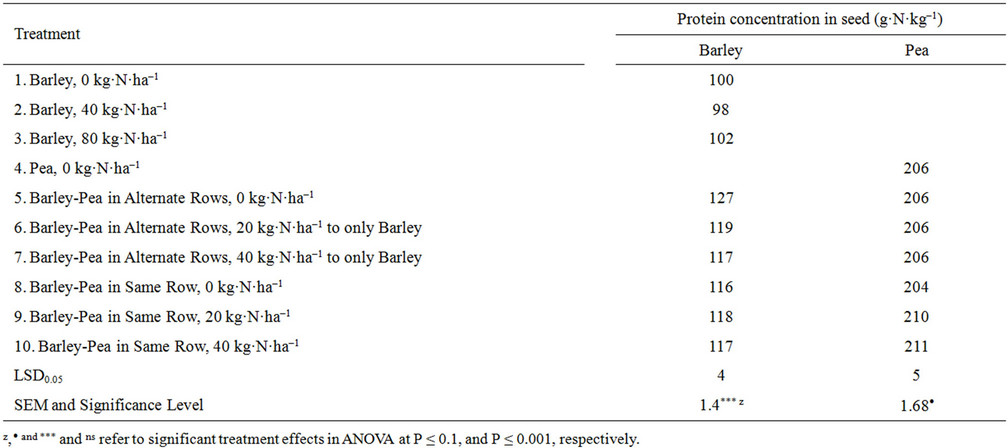
Table 6. Protein concentration in seed of barley and pea grown as sole crops compared to various combinations of barley and pea intercrop treatments for similar N rates at Star City, Saskatchewan (average of 2009 to 2011, Experiment 1).
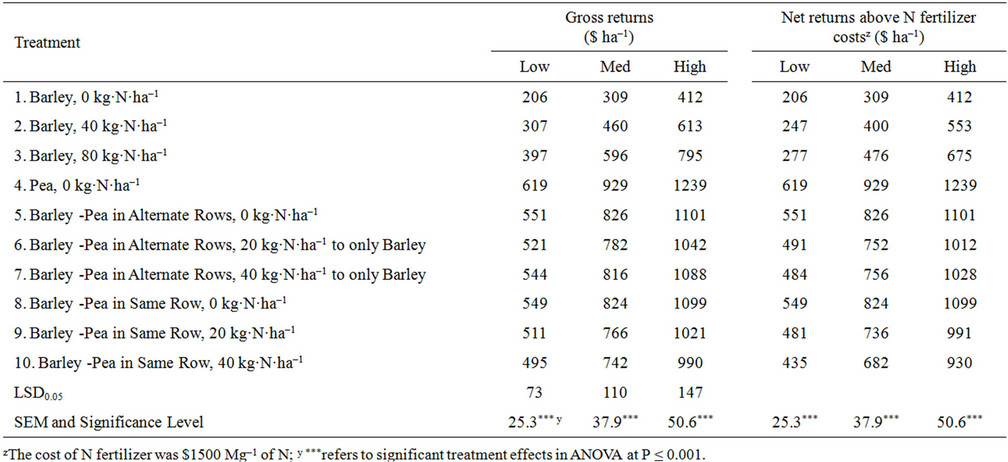
Table 7. Economic returns for barley and pea grown as sole crops, and in various combinations as intercrop in alternate rows and in same row at low ($100 Mg–1 for barley and $200 ha–1 for pea), medium ($150 Mg–1 for barley and $300 ha–1 for pea) and high ($200 Mg–1 for barley and $400 ha–1 for pea) prices at Star City, Saskatchewan (average of 2009 to 2011, Experiment 1).
as a sole crop. Net returns decreased with N fertilization when the intercrops were seeded in alternate rows and more so in the same row, suggesting that N fertilization to barley-pea intercrops has no net economic benefit, in spite of slight increase in seed yield.
3.2. Canola-Pea Intercrop (Experiment 2)
3.2.1. Yield, Land Equivalency Ratio and N Uptake
Like barley, seed yield of canola as sole crop also increased considerably with application of N (Table 8). Seed yield of canola in intercrop increased with N fertilization, but the increases were small and significant only when both crops were seeded in the same row. There was also small increase (but not significant) in seed yield of pea with application of 20 kg·N·ha–1 in both intercrop combinations. The LER values for the corresponding N rate treatments were much greater than 1 for both intercropping combinations, but tended to decrease with increasing N rate. Total N uptake in seed for canola and pea as sole crops as well as when sown as intercrop in both combinations showed trends similar to seed yield (Table 8). The LER values for total N uptake in seed also showed patters similar to LER for seed yield.
The LER values in the canola-pea intercrop in both same row and alternative rows combinations were greater when sole crop of canola was grown at zero-N compared to application of N fertilizer, with the lowest LER values at 80 kg·N·ha–1 rate (Table 9). This indicated the highest crop yield and lowest land requirement for canola-pea intercrops, when sole crop of canola was grown without any applied N fertilizer. For all canola as sole crop treatments, the LER values increased with increasing N rate in the canola-pea intercrop, especially when seeded in the same row. This suggests the increase in seed yield and decrease in land requirement for canola-pea intercrop with increasing rate of applied N.
Total of seed or straw yield of canola + pea together tended to increase with applied N in both intercrop combinations and more so for straw yield (Table 10). Seed and straw yield of canola as sole crop increased substantially with application of N. Seed yield of pea as sole crop (with no N applied) was much greater than canola as sole crop receiving 0 to 80 kg·N·ha–1 rates, but it was similar to canola-pea intercrop in alternate rows and slightly greater than when both were seeded in same row without applied N. Straw yield of pea as sole crop (with no N applied) was much greater than canola as sole crop at only 0 kg·N·ha–1 rate, but it was lower than that of in both intercrop combinations regardless of N application rate. Seed + straw yields usually followed trends similar to straw yields. Response trends of total N uptake in seed, straw or seed + straw to various treatments were similar to corresponding yield of seed, straw or seed + straw (Table 10).
3.2.2. Seed Quality
In treatments without any applied N, protein concentration in canola seed was highest when canola was intercropped with pea (Table 11). In the applied N treatments, protein concentration in canola seed tended to decrease with N rate in both canola-pea intercrop com-
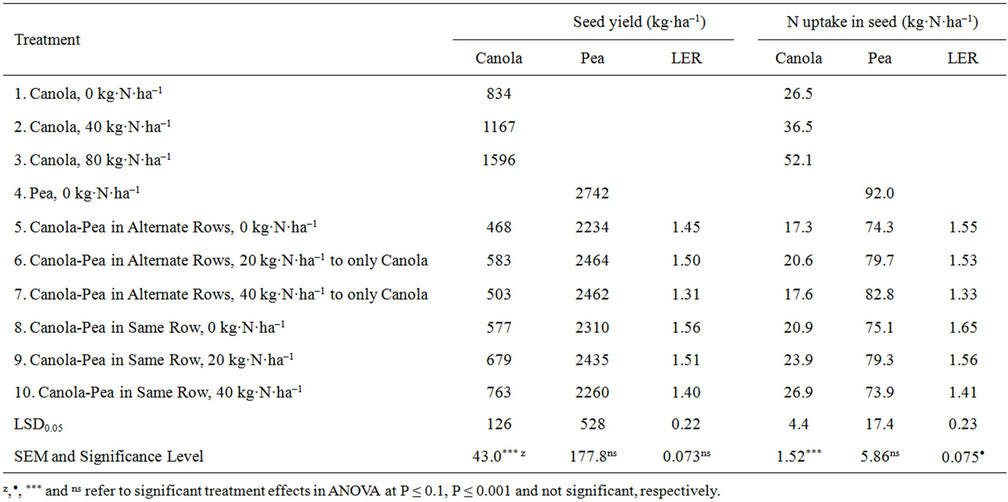
Table 8. Seed yield, N uptake in seed and land equivalency ratio (LER) for canola or pea, grown as sole crops or in various intercrop combinations at Star City, Saskatchewan (average of 2009 to 2011, Experiment 2).

Table 9. Land equivalency ratio (LER) for canola with or without applied N and pea without applied N grown as sole crops or in various intercrop combinations at Star City, Saskatchewan (average of 2009 to 2011, Experiment 2).
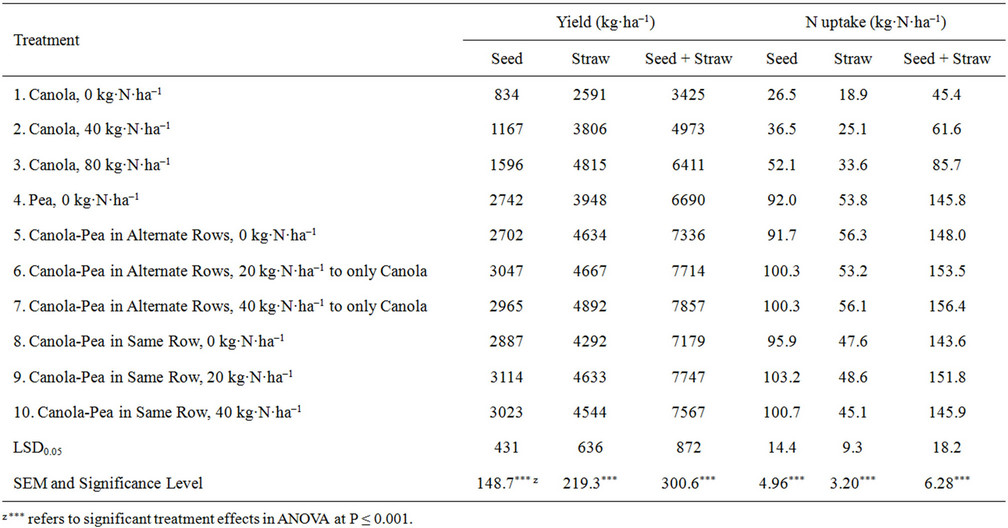
Table 10. Yield and N uptake of seed, straw and seed + straw for both crops of canola and/or pea together, grown as sole crops or in various intercrop combinations at Star City, Saskatchewan (average of 2009 to 2011, Experiment 2).
binations. Protein concentration in pea seed was greater when pea was grown in intercrop compared to pea as sole crop, but there was no additional benefit of N fertilization on protein concentration in pea seed in both intercrop combinations. Oil concentration in canola seed was lower in both canola-pea intercrop combinations compared to canola as sole crop, especially when no N was applied to intercrops (Table 11). Oil concentration in canola seed increased with N fertilization in both canola-pea intercrop combinations.
3.2.3. Economic Returns
Net returns of canola as sole crop increased dramatically with application of N, but these net returns were much lower than that in canola-pea intercrop combinations or pea as sole crop (Table 12). Net returns in canola-pea intercrops without applied N were highest when both crops were seeded in the same row, and this was followed closely by intercrops seeded in alternate rows, which in turn was slightly greater than pea as sole crop. In both intercrop combinations, the net returns first in-
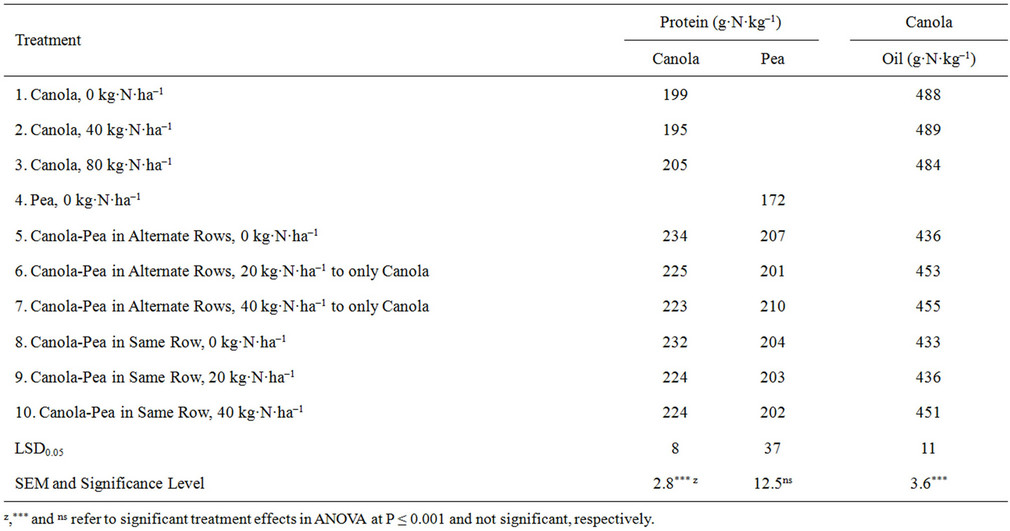
Table 11. Protein and oil concentration in seed of canola and pea grown as sole crops compared to various combinations of canola and pea intercrop treatments for similar N rates at Star City, Saskatchewan (average of 2009 to 2011, Experiment 2).
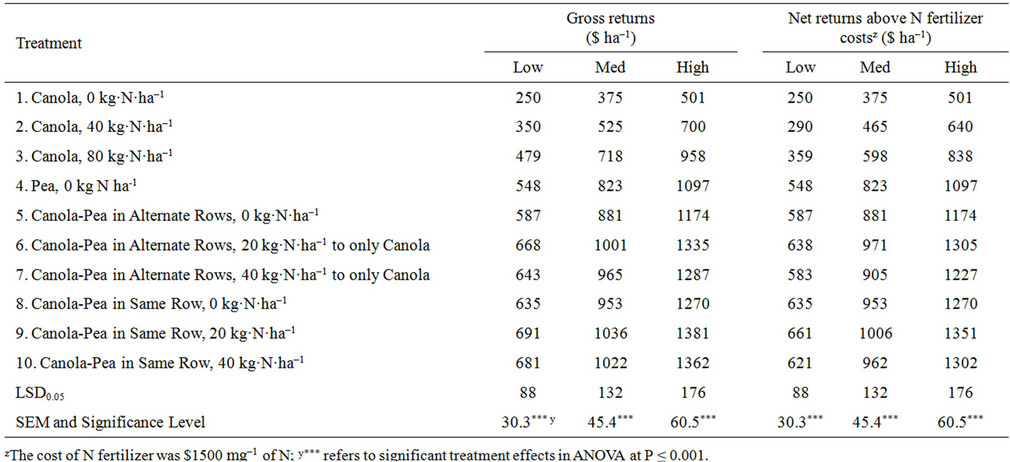
Table 12. Economic returns for canola and pea grown as sole crops, and in various combinations as intercrop in alternate rows and in same row at low ($300 Mg–1 for canola and $200 ha–1 for pea), medium ($450 Mg–1 for canola and $300 ha–1 for pea) and high ($600 Mg–1 for canola and $400 ha–1 for pea) prices at Star City, Saskatchewan (average of 2009 to 2011, Experiment 2).
creased with application of 20 kg·N·ha–1 and then decreased beyond this N rate.
4. DISCUSSION
Earlier studies have explored the feasibility of intercropping grain legumes with various cereal [4,5,9] or oilseed [10] crops to improve land productivity, economic returns and produce quality. The present study considered barley-pea or canola-pea intercrop mixtures as alternatives to barley, canola or pea sole crops in the Parkland region of western Canada under sub-humid climatic conditions. The following section discusses the effects of intercropping versus sole cropping in relation to crop production, land resource use efficiency, produce quality and N uptake, by providing possible explanations for any varying results from the published literature.
Previous research has established that pea-barley or pea-mustard intercrop produces greater seed yield than pure crops, in spite of the reduction in seed yield of the components [4,25]. This was attributed to a strong competition from cereals or oilseeds to pea in mixed intercropping [4,26]. Similarly, in our study barley or canola and pea intercrops produced greater seed yield than sole/pure crops, and seed yield of pea and barley or canola components decreased when grown in intercrop compared to grown as pure crops. Greater biomass production of intercrops, which in turn produced greater seed production, than sole crops could be possibly due to enhanced light interception because of greater canopy, especially for canola [27,28].
The LER values greater than 1 indicate higher crop yield and lower land requirement with intercropping compared to when barley and pea were grown as sole crops, especially when grown without applied N. The increase in seed yield of canola and decrease in seed yield of pea with application of N fertilizer compared to zero-N treatment could be most likely due to higher level of nitrate-N in soil which has been observed to favour competition of non-legume canola over legume pea [26, 29-31].
In our study, seed yields of the component crops in intercrop mixtures were much lower than their corresponding sole crop seed yields, but the total land productivity was usually higher in intercrop treatments as evidenced by higher LER values. For example, the LER values ranged from 1.15 to 1.50 for intercrops in alternate rows, and from 1.07 to 1.56 for intercrops in same row. In other words, sole cultivation of each crop would require more land than their cultivation in intercrop mixture, suggesting greater land-use efficiency of intercrops ((by 15 to 50% for alternate rows and by 7 to 56% for same row).) than sole crops. Because of different rooting pattern, intercropping legumes with oilseeds or cereals has the potential to improve the use of soil N resource compared to legumes grown as sole crops [2]. Therefore, it is also possible that higher land productivity under intercropping than sole cropping in our study was most likely due to more efficient use of available soil N with intercrops. Also, in our study there was more N uptake with intercrop combinations than sole crops. Similar results were reported previously in intercropping systems for mixed cultures of barley and pea [1,32] or oilseed rape/canola/mustard and pea [3,10]. The higher LER values of intercrops when grown in same row than alternate rows indicates that intercropping was superior when root systems of non-legume and legume crops are intermixed because of most likely the differences in the use of different sources of N and possibly other nutrients, as also suggested by Martin and Snaydon [33].
The highest LER values when sole crop of canola was grown at zero-N compared with application of N fertilizer indicate greatest crop yield and lowest land requirement for canola-pea intercropping grown without any applied N fertilizer. This suggests increase in seed yield and decrease in land requirement for canola sole crop receiving increasing rate of applied N. This also suggests large advantage in favour of intercropping/mixed cropping, in spite of application of N fertilizer to oilseed or cereal crops. The increased in LER values with increasing N rate from 0 to 40 kg·N·ha–1 in both canola-pea intercrop combinations suggests increase in seed yield and decrease in land requirement for canola-pea intercrop with increasing rate of applied N.
Knudson et al. [34] suggest that interspecies competetion can cause increase in the concentration total N in seed of barley when it is grown as a mixture with pea, due to lack of severe competition for N between the crops. In our study, the protein concentration (or total N) also increased in seed of barley-pea or canola-pea mixed intercrops, because more of soil N was available to barley or canola seeds, as pea fixes its own N requirement from the atmosphere.
Our findings suggest that if organic farming has limited possibilities for using manure, the inclusion of N-fixing legume grain crops can be introduced in the intercropping systems for preventing N deficiency in organic crops. Our results also show considerably more gain in protein yield with barley-pea or canola-pea intercrops than pure barley or canola crops, especially when no N fertilizer was applied. In summary, the barley-pea or canola-pea intercrops produced the highest seed yields, while also improving the sustainability of economic returns.
5. CONCLUSION
Compared to barley and pea as sole crops without applied N, crop yield, N uptake and LER improved with barley-pea intercrop. Seed yield, N uptake and LER also increased with canola-pea intercrop, particularly compared to canola as a sole crop. In barley-pea and canola-pea intercrop systems, seed yield of both crops together increased only slightly with application of N fertilizer. Net returns in both barley-pea and canola-pea intercrop systems improved greatly when no N fertilizer was applied, although the net returns were highest for pea grown as a sole crop without applied N in the barley-pea intercrop. In summary, intercrop of barley or canola with pea improved crop yield, N uptake and net returns, and reduced land requirements compared to barley, canola or pea as sole crops. The findings suggest the potential of barley-pea intercrop, canola-pea intercrop and pea for organic farming systems.
6. ACKNOWLEDGEMENTS
The author thanks Western Alfalfa for supplying alfalfa pellets amendment, International Compost Ltd., Calgary, Alberta, for supplying rock phosphate fertilizers for this study, and D. Leach, K. Strukoff and P. Boxall for technical help.
REFERENCES
- Jensen, E.S. (1996) Grain yield, symbiotic N2 fixation and interspecific competition for inorganic N in pea-barley intercrops. Plant and Soil, 182, 25-38. doi:10.1007/BF00010992
- Hauggaard-Nielsen, H., Ambus, P. and Jensen, E.S. (2001) Temporal and spatial distribution of roots and competetion for nitrogen in pea-barley intercrops—A field study employing 32P technique. Plant and Soil, 236, 63-74. doi:10.1023/A:1011909414400
- Aktar, M.S., Shamsuddin, A.M., Islam, N. and Rahman, A.R.M.S. (1993) Effects of mixed cropping lentil and mustard at various seeding ratios. Lens, 20, 36-39.
- Hauggaard-Nielsen, H. and Jensen, E.S. (2001) Evaluating pea and barley cultivars for complementarity in intercropping at different levels of soil N availability. Field Crops Research, 72, 185-196. doi:10.1016/S0378-4290(01)00176-9
- Szczukowski, S. (1989) Yield and seed quality of field peas grown in mixtures with cereals and in pure stands. Acta Academiae Agriculturae ac Technicae Olstenensis, Agricultura, 47, 40.
- Carr, P.M., Gardner, J.C., Schatz, B.G., Zwinger, S.W. and Guldan, S.J. (1995) Grain yield and weed biomass of a wheat-lentil intercrop. Agronomy Journal, 87, 574-579. doi:10.2134/agronj1995.00021962008700030030x
- Paolini, R., Caporali, F. and Campiglia, E. (1993) Yield response, complementarity and competitive ability of bread wheat and pea in mixtures. Agricoltura Mediterranea, 123, 114-121.
- Rauber, R., Schmidtke, K. and Kimpel-Freund, H. (2000) Competition and yield advantage in mixtures of pea (Pisum sativum L.) and oats (Avena sativa L.). Konkurrenz und ertragsvorteile in gemengen aus erbsen (Pisum sativum L.) und hafer (Arena sativa L.), 185, 33-47.
- Chalmers, S. and Day, S. (2009) Optimum seeding combinations for intercropping peas and canola: An investigation with surprising yields and other final stand effects. Manitoba Agronomists Conference, Winnipeg. http://umanitoba.ca/afs/agronomists_conf/proceedings.html
- Jetendra, K. and Mishra, J.P. (1999) Influence of planting pattern and fertilizers on yield and yield attributes and nutrient uptake in pea/mustard intercropping system. Indian Journal of Pulses Research, 12, 38-43.
- Zielinska, A. and Rutkowski, M. (1988) Comparison of productivity of oats, barley and four cultivars of field peas in pure and mixed sowing. Acta Academiae Agriculturae ac Technicae Olstenensis, Agricultura, 46, 113- 124.
- Hiebesch, C.K. and McCollum, R.E. (1987) Area x time equivalency ratio: A method for evaluating the productivity of intercrops. Agronomy Journal, 79, 15-22. doi:10.2134/agronj1987.00021962007900010004x
- de Wit, C.T. and van den Bergh, J.P. (1965) Competition between herbageplants. Netherlands Journal of Agricultural Science, 13, 212-221.
- Szumigalski, A.R. and van Acker, R.C. (2008) Land equivalent ratios, light interception, and water use in intercrops in the presence or absence of in-crop herbicides. Agronomy Journal, 100, 1145-1154. doi:10.2134/agronj2006.0343
- Poggio, S.L. (2005) Structure of weed communities occurring in monoculture and intercropping of field pea and barley. Agriculture, Ecosystems and Environment, 109, 48-58. doi:10.1016/j.agee.2005.02.019
- Helenius, J. (1991) Insect numbers and pest damage in intercrops vs. monocrops: Concepts and evidence from a system of faba bean, oats and Rhopalosiphum padi (Homoptera, Aphididae). Journal of Sustainable Agriculture, 1, 57-80.
- Paras, N. and Chakravorty, S. (2005) Effect of intercropping on the infestation of chickpea pod borer Helicoverpa armigera (Hubner). Journal of Plant Protection and Environment, 2, 86-91.
- Chen, Y., Zhang, F., Tang, L., Zheng, Y., Li, Y., Christie, P. and Li, L. (2007) Wheat powdery mildew and foliar N concentrations as influenced by N fertilization and belowground interactions with intercropped faba bean. Plant and Soil, 291, 1-13. doi:10.1007/s11104-006-9161-9
- Danso, S.K.A. and Papastylianou, I. (1992) Evaluation of the nitrogen contribution of legumes to subsequent cereals. Journal of Agricultural Science, 119, 13-18. doi:10.1017/S0021859600071495
- Izaurralde, R.C., McGill, W.B. and Juma, N.J. (1992) Nitrogen fixation efficiency, interspecies N transfer, and root growth in barley-field pea intercrop on a Black Chernozemic soil. Biology and Fertility of Soils, 13, 11- 16. doi:10.1007/BF00337231
- Hauggaard-Nielsen, H., Andersen, M.K., Jornsgaard, B. and Jensen, E.S. (2006) Density and relative frequency effects on competitive interactions and resource use in pea-barley intercrops. Field Crops Research, 95, 256-267. doi:10.1016/j.fcr.2005.03.003
- Noel, R.J. and Hambleton, L.G. (1976) Collaborative study of a semi-automated method for the determination of crude protein in animal feeds. Journal of Association of Official Analytical Chemists, 59, 134-140.
- Snedecor, G.W. and Cochran, W.G. (1967) Statistical methods. 6th Edition, The Iowa State University Press, Ames.
- SAS Institute Inc. (2004) Online documentation for SAS, version 8. http://support.sas.com/documentation/onlinedoc/index.html
- Banik, P., Sasmal, T., Ghosal, P.K. and Bagchi, D.K. (2000) Evaluation of mustard (Brassica compestris var. Toria) and legume intercropping under 1:1 and 2:1 row-replacement series system. Agronomy and Crop Science, 185, 9-14. doi:10.1046/j.1439-037X.2000.00388.x
- Anderson, M.K., Hauggaard-Nielsen, H., Ambus, P. and Jensen, E.S. (2004) Biomass production, symbiotic nitrogen fixation and inorganic N use in dual and tri-component annual intercrops. Plant and Soil, 266, 273-287. doi:10.1007/s11104-005-0997-1
- Kushwaha, B.L. and De, R. (1987) Studies of resource use and yield of mustard and chickpea grown in cropping systems. Journal of Agriculture Science (Cambridge), 108, 487-495. doi:10.1017/S0021859600079533
- Morris, R.A. and Garrity, D.P. (1993) Resource capture and utilization in intercropping. Water Field Crops Research, 34, 303-317. doi:10.1016/0378-4290(93)90119-8
- Francis, C.A. (1989) Biological efficiencies in multiplecropping systems. Advances in Agronomy, 42, 1-42. doi:10.1016/S0065-2113(08)60522-2
- Cowell, L.E., Bremer, E. and van Kessel, C. (1989) Yield and N-2 fixation of pea and lentil as affected by intercropping and N application. Canadian Journal of Soil Science, 69, 243-251. doi:10.4141/cjss89-025
- Waterer, J.G., Vessey, J.K., Stobbe, E.H. and Soper, R.J. (1994) Yield and symbiotic nitrogen-fixation in a pea mustard intercrop as influenced by N fertilizer addition. Soil Biology and Biochemistry, 26, 447-453. doi:10.1016/0038-0717(94)90176-7
- Chen, C., Westcott, M., Neil, K., Wichmann, D. and Knox, M. (2004) Row configuration and nitrogen application for barley-pea intercropping in Montana. Agronomy Journal, 96, 1730-1738. doi:10.2134/agronj2004.1730
- Martin, M.P.L.D. and Snaydon, R.W. (1982) Root and shoot interactions between barley and beans when intercropped. Journal of Applied Ecology, 19, 263-272. doi:10.2307/2403009
- Knudson, M.T., Hauggaard-Nielsen, H., Jørnsgaard, B. and Jensen, E.S. (2004) Comparison of interspecific competition and N use in pea-barley, faba bean-barley and lupin-barley intercrops grown at two temperate locations. Journal of Agriculture Science, 142, 617-627. doi:10.1017/S0021859604004745

